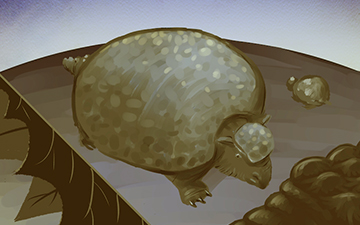Glyptodon (Greek for “grooved or carved tooth”) was a large, armored mammal of the family Glyptodontidae, a relative of armadillos that lived during the Pleistocene epoch. It was roughly the same size and weight as aVolkswagen Beetle, though flatter in shape. With its rounded, bony shell and squat limbs, it superficially resembled turtles, and the much earlier dinosaurian ankylosaur, as an example of the convergent evolution of unrelated lineages into similar forms. Glyptodon is believed to have been a herbivore, grazing on grasses and other plants found near rivers and small bodies of water.
Glyptodon measured 3.3 m (10.8 ft) in length, 1.5 m (4.9 ft) in height and weighed up to 2 tonnes.[5] It was covered by a protective shell composed of more than 1,000 2.5 cm-thick bony plates, called osteoderms or scutes. Each species of glyptodont had its own unique osteoderm pattern and shell type. With this protection, they were armored like turtles. Unlike most turtles, glyptodonts could not withdraw their heads, but instead had a bony cap on the top of their skull. Even the tail of Glyptodon had a ring of bones for protection. Such a massive shell needed considerable support, evidenced by features such as fused vertebrae, short but massive limbs, and a broad shoulder girdle.[6]
The nasal passage was reduced with heavy muscle attachments for some unknown purpose. Some have speculated that the muscle attachments were for a proboscis, or trunk, much like that of a tapir or elephant. The lower jaws were very deep and helped support massive chewing muscles to help chew coarse fibrous plants; a distinctive bar of bone projects downwards on the cheek, extending over the lower jaw, perhaps providing an anchor for powerful snout muscles. Another suggestion, made by A.E. Zurita and colleagues, is that the large nasal sinuses could be correlated with the cold arid climate of Pleistocene South America.[7][8]
(From Wikipedia, May 2015)




